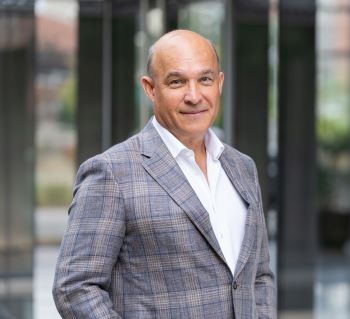Global polycrisis requires Canada to transform its financial systems to support innovation
Canada can no longer risk not innovating and continuing to invest in systems that are destroying social cohesion and natural biodiversity, says a developer of transformative financial instruments that address key social problems.
 The “polycrisis” impacting Canada means innovation is a necessity for responding to these interconnected multiple global crises and transitioning to a healthier, more sustainable and equitable world, said Anastasia Mourogova Millin (photo at right), founder of Montreal-based Ombrello Solutions and DanSa Capital Innovation.
The “polycrisis” impacting Canada means innovation is a necessity for responding to these interconnected multiple global crises and transitioning to a healthier, more sustainable and equitable world, said Anastasia Mourogova Millin (photo at right), founder of Montreal-based Ombrello Solutions and DanSa Capital Innovation.
“We are at a very particular point in history where all the crises that we as humans have created are now self-feeding,” she said in the opening keynote talk at Research Money’s annual conference, “Embracing Transition: Opportunity and Responsibility to Create a Better Future,” in Ottawa.
These crises include climate change, homelessness, lack of nature and destruction of biodiversity, the impacts of industrial agriculture, water pollution and more.
“The crises are only getting deeper and they’re only getting faster,” Mourogova Millin said. “So the transition today matters and the innovation that will lead to that transition also matters.”
Canadians can no longer afford to absorb the risk of the current financial systems, she said.
“We can no longer afford the capital – every form of capital: our pensions, our RRSPs, our children’s RESPs – to finance the models that are literally self-exterminating us,” Mourogova Millin said.
“If we get the innovation wrong right now, then we don’t have time anymore to go into the wrong pathway because the wrong pathway will get us to self-extermination that much faster.”
Mourogova Millin has more than two decades of corporate banking experience and an in-depth knowledge of the commercial real estate sector.
She helped launch the first Canadian community-first, values-based bank – Vancity Community Investment Bank, where she oversaw the transformation of a $1.3-billion existing real estate portfolio towards social impact and brought in $250 million in new loans to B Corps, social enterprises and not-for-profits. (B Corps are not-for-profit companies certified by the international nonprofit network B Lab to meet high standards of social and environmental performance, transparency and accountability).
In her subsequent role as global director of capital and investments at Dark Matter Labs, Mourogova Millin focused on building new markets for a portfolio of civic infrastructure, including nature-based solutions such as soil health and biodiversity, to re-imagine the existing systems of capital formation, deployment and value aggregation.
In October 2022 she founded Ombrello Solutions and DanSa Capital Innovation, with a goal to develop and implement innovative financial instruments that transition private and institutional capital at scale towards key societal challenges.
Ombrello Solutions is a not-for-profit organization that works hand-in-hand with DanSa Capital Innovation and a portfolio of external stakeholders to collectively co-create transformative capital instruments.
Mourogova Millin grew up as a child in the Soviet Union, where she said she saw what it was like not to have institutions that people could depend on.
Her father still lives in Russia, where Mourogova Millin said a typical pension is about $200 a month and rent costs $1,000 a month.
“That’s why in Russia nobody smiles. When I smile, they call me a foreigner,” she said.
Canadians like to complain about their institutions, including government, schools and banks, she noted. But, she added: “Institutions matter. We take them for granted, and yet in a country where there are no institutions, that’s a country where on the street you can’t trust anyone because they don’t trust themselves.”
“I feel like in Canada we’ve done just an amazing job creating institutions,” she said. “We have every single ingredient [needed to transition from the polycrisis].”
The cost and risk of Canada’s current financial systems
At the same time, Canadian institutions and their structures need to change to manage the global polycrisis and the transition to a clean-energy, sustainable economy, Mourogova Millin said.
She pointed to the example of Finland, which adopted extensive use of digital learning tools and other technologies in its high schools about 10 years ago. Last year, Finland’s government acknowledged that the move was a mistake because the country’s teenagers became addicted to technology, and the tech-heavy education program would end.
“That takes humility: the entire program scrapped, for a county that’s supposed to be a leader in education,” Mourogova Millin said.
For Canada and its financial systems, innovation includes moving away from existing banking regulations, accounting standards and legal frameworks, to create new forms of capital and financial instruments, she said.
“What if every type of capital – private capital, public capital, institutional capital – starts not [by] funding the crises but starts funding the very things that make the future for our children possible?”
Consider the cost – and the risk – of not innovating and leaving the current systems as is, Mourogova Millin said. Consider the cost of agriculture forever staying industrial, natural biodiversity fully disappearing, water not being drinkable or air being toxic.
“Let’s innovate for risk. Let’s move the innovation from the marketing department to the credit [department]. Let it become at the core of every institution,” she said.
In Canada, she said, most of Canadians’ wealth sits in private family offices that provide wealth management to family-owned businesses such as Loblaw Companies Limited, George Weston Ltd., Power Corp. of Canada, McCain Foods and others – and in pension funds.
Sixty percent of all the assets that pension funds are invested in are in real estate, she noted.
What happens if the impact of climate change gets worse and many of those properties are flooded? she asked.
The cascading effect of entire portfolios of properties getting flooded is that the insurance companies will no longer insure these at-risk properties, so they no longer have value, Mourogova Millin said. “All of a sudden billions of dollars of our money cannot be renegotiated. So there’s a liquidity risk that becomes an issue.”
She said that as a former corporate banker, she has looked at the balance sheets of Canada’s private family offices and pension funds.
“The truth is there’s going to be a moment when the entire portfolio that’s real estate is going to go down by 40 to 50 percent,” she said.
“I’ve priced in what will happen if the real estate market goes down. Depending on where you are, it might not be that bad. In Canada, it’s horrendous.”
At the same time, the homelessness problem in downtown Montreal and Toronto has resulted in “businesses are moving away by streets,” Mourogova Millin said. “Entire streets are empty because of homelessness.”
“You combine climate risk and that societal risk and all of a sudden your real estate – even if it’s somehow net-zero climate sustainable – is not livable,” she said.
People then arrive at retirement to suddenly find 60 percent of their investment portfolio has declined by half. “Imagine that happening [in a cascade] to pension funds and all the private family offices.”
A community-focused municipal bond market could help build infrastructure
The only people standing between that stark reality and the “North Star” of a more sustainable, community-focused world are the entrepreneurs working on solutions to society’s key problems, Mourogova Millin said.
Yet under current banking systems, it’s nearly impossible for entrepreneurs and owners of innovative small businesses to get a bank loan, she said. “If they do get an [impact] loan, banks will price it double to what a non-impact loan will be.” [An impact loan is a form of lending where the focus is on generating positive social or environmental outcomes in addition to financial returns].
“So we make entrepreneurs carry all the risk of being an entrepreneur, plus taking the risk of going for an impact dream,” Mourogova Millin said. And [we’re] making them pay double and go through the hoops just to get the money.”
But if every entrepreneur could have access to the capital they need and be motivated for the work they’re doing, it would help reduce the risk to people’s pensions and retirement savings of a real estate collapse or some other crisis, she said.
Mourogova Millin said she thinks of innovation in terms of “horizons.” A “first horizon” innovation is one that’s relatively easy to integrate into a current system. A “second horizon” innovation requires a change in mind-set, “which is probably the hardest thing out there. If it requires a shift toward the world we want to see rapidly, then it’s second horizon.”
One of the mechanisms the U.S. has that enables the American society to function and in certain places to flourish is an extensive and diverse municipal bond market, Mourogova Millin said.
Canada lacks such a well-developed municipal bond, which is one reason that pension funds, banks and public financing invest so much in real estate but don’t invest in critical and much-needed infrastructure such as affordable housing and natural assets and biodiversity, she said. “We don’t have a place in Canada to trade obligations.”
Infrastructure by default requires a lot of upfront capital and can take up to 30 years before the return on investment is realized. Pension funds and other types of investors need to know that if during that time they need to sell part of their investment, there’s a market for it where that obligation can be sold or traded without much of a discount.
“Because we don’t have a municipal bond market, what happens is a liquidity premium,” typically around two percent, that gets priced in to the future sale of the investment.
A first horizon innovation for Canada would be to create a municipal bond platform and market where investors in infrastructure could trade their investments and obligations, Mourogova Millin said.
Local credit unions and local communities would source the infrastructure projects and communities would receive ownership in every project. Credit unions would underwrite the loans and be paid for that underwriting process.
“So all of a sudden you’ve boosted your credit union market and you give one percent ownership to every community, so you boost your community resilience.”
Government would backstop or guarantee the “settlement risk” if an investor takes longer than expected to settle or something unforeseen happens, which would remove the two-percent premium, Mourogova Millin added. “This means you can actually structure a proper investment product.”
For example, the City of Calgary expects to save millions of dollars over the next 10 years through its first municipal bond.
The city closed its first municipal bond in the Canadian debt capital markets last March, obtaining a lower interest rate than its traditional borrowing option through the provincial government. Lower borrowing costs help reduce city costs, making Calgary more affordable and enabling additional capital project investments in the community.
Ensure community ownership and collective governance of funded assets
Ombrello Solutions and DanSa Capital embed transformative legal structures at the core of all investment mechanisms that ensure community ownership and collective governance of the funded assets on the ground.
The partners work with local solution providers to build out a robust pipeline of projects that are ready to be funded from the proceeds of the investment mechanisms.
According to Ombrello Solutions’ website, the partners are currently in the process of researching, designing and structuring two market-making investment mechanisms:
- a $250-milllion Civic Infrastructure Bond, which will pool private and institutional capital at scale and finance a portfolio of urban natural assets that increase cities' climate resilience and benefit communities in every neighbourhood.
- a $100-million Homeless Bond, which is catered to impact investors and whose proceeds will provide 500 individuals and families currently living in shelters due to evictions with permanent homes.
Three problems that prevent cities from being healthy are a lack of nature and destruction of biodiversity, homelessness, and lack of attainable housing, the partners say.
“By creating systemic investment mechanisms we are aiming to demonstrate how private and institutional capital could flow at scale to these civic assets while the value produced by them is redistributed democratically between private stakeholders and community, thus addressing key societal and climate needs.”
At Research Money’s conference, Mourogova Millin shared an idea for second horizon innovation – the type that requires a change in mind-set – in financing instruments.
Negative interest rates have been used by some countries and a lot of data shows the approach works, she said.
This approach would entail regulatory policy that requires banks, in providing impact loans to entrepreneurs, developers and others, to cut their interest rates for these loans for projects and innovations that provide solutions that benefit society.
Banks essentially would pay entrepreneurs and others to borrow, “paying them for the privilege of putting [their] capital into that solution,” Mourogova Millin said.
Such negative interest rates would be paired with a tax incentive for banks that provide impact loans. “For every dollar that you lend to the small businesses that are doing [social] impact, you will get a tax break plus your cost of capital is going to be negative.”
“So all of a sudden as a bank, you change how you’re allocating [investment and loan] targets,” Mourogova Millin said.
Actually implementing negative interest rate loans would require key stakeholders to be at the table, including chief risk officers at banks, government regulators and chairs of corporate boards, she said.
If such an idea sounds impossible in Canada, Mourogova Millin had a message for Research Money conference delegates: “I’d ask that you don’t think of innovation as a ‘nice to have’ anymore. [That you] truly think of innovation as: ‘What is the cost of not doing it. What is the cost of the status quo?’”
R$
| Organizations: | |
| People: | |
| Topics: |
Events For Leaders in
Science, Tech, Innovation, and Policy
Discuss and learn from those in the know at our virtual and in-person events.
See Upcoming Events
You have 0 free articles remaining.
Don't miss out - start your free trial today.
Start your FREE trial Already a member? Log in
By using this website, you agree to our use of cookies. We use cookies to provide you with a great experience and to help our website run effectively in accordance with our Privacy Policy and Terms of Service.




